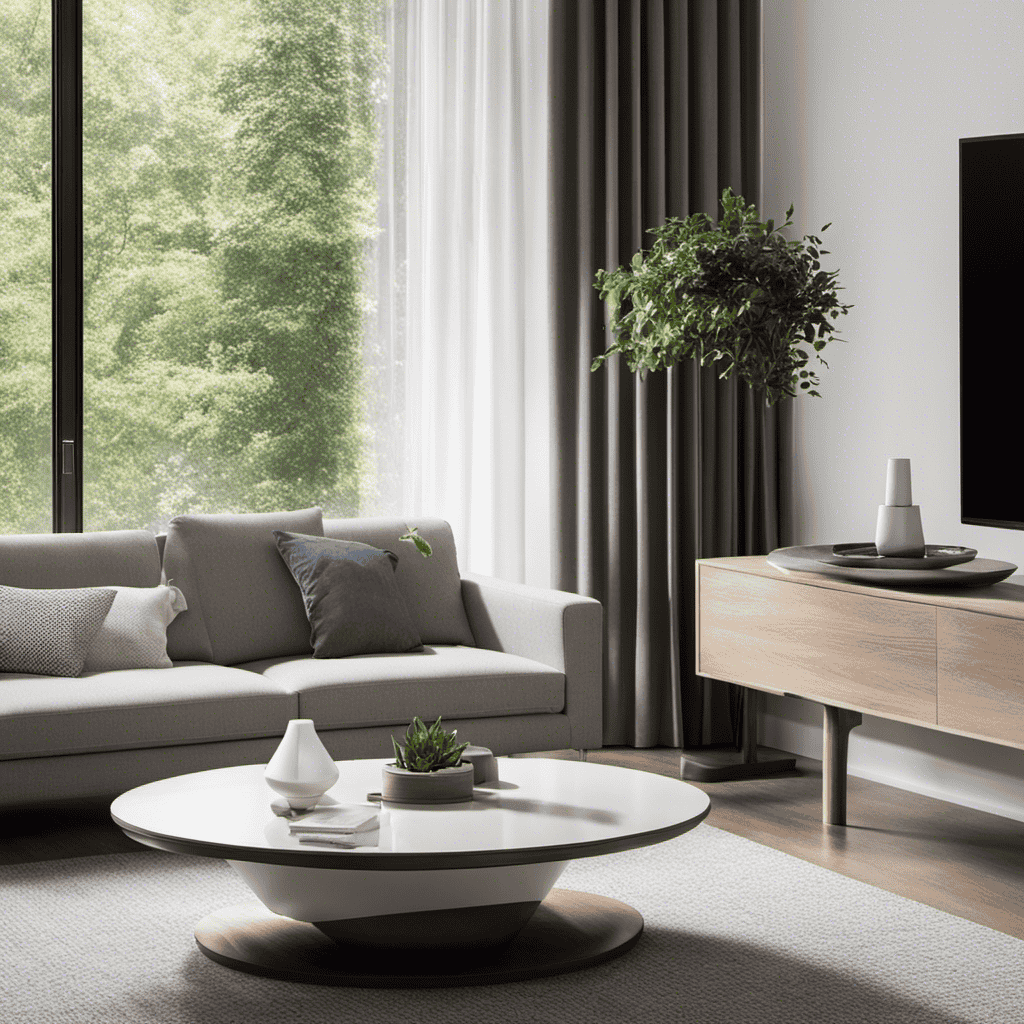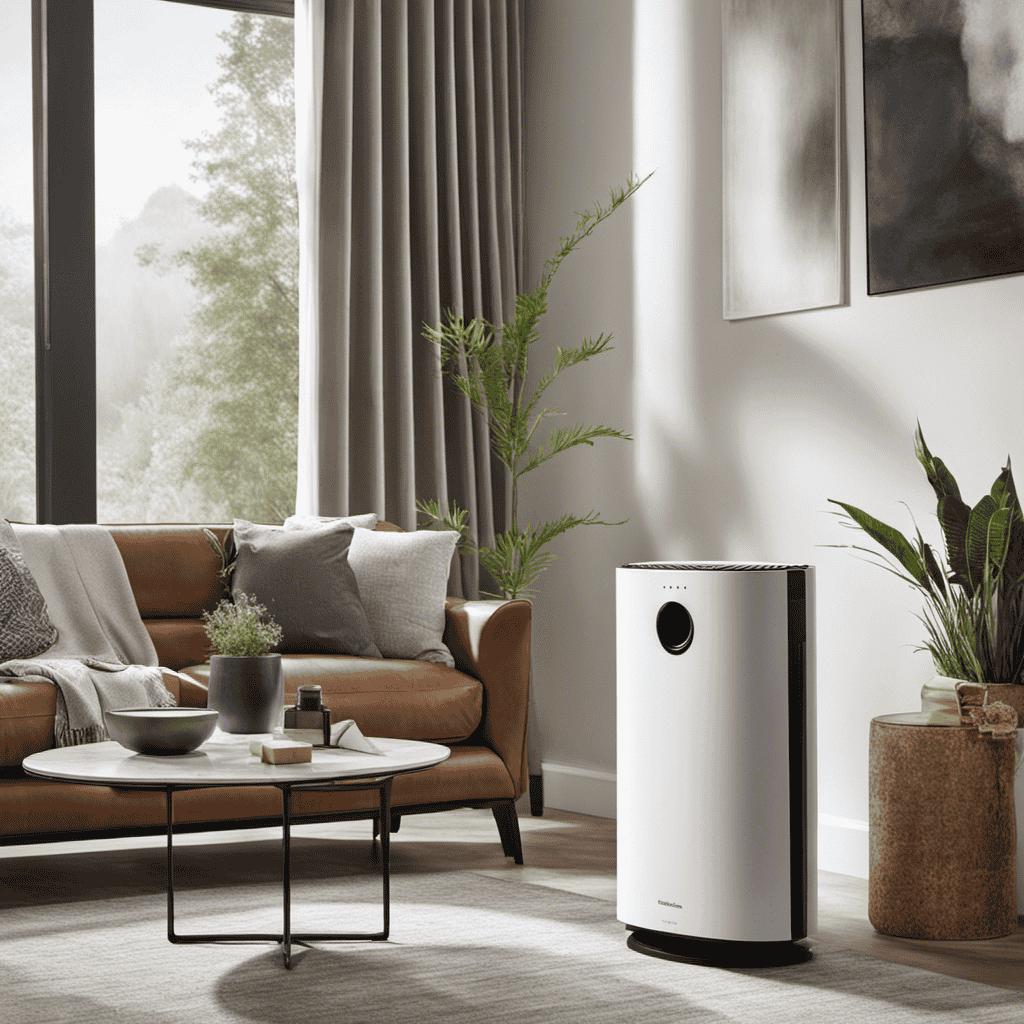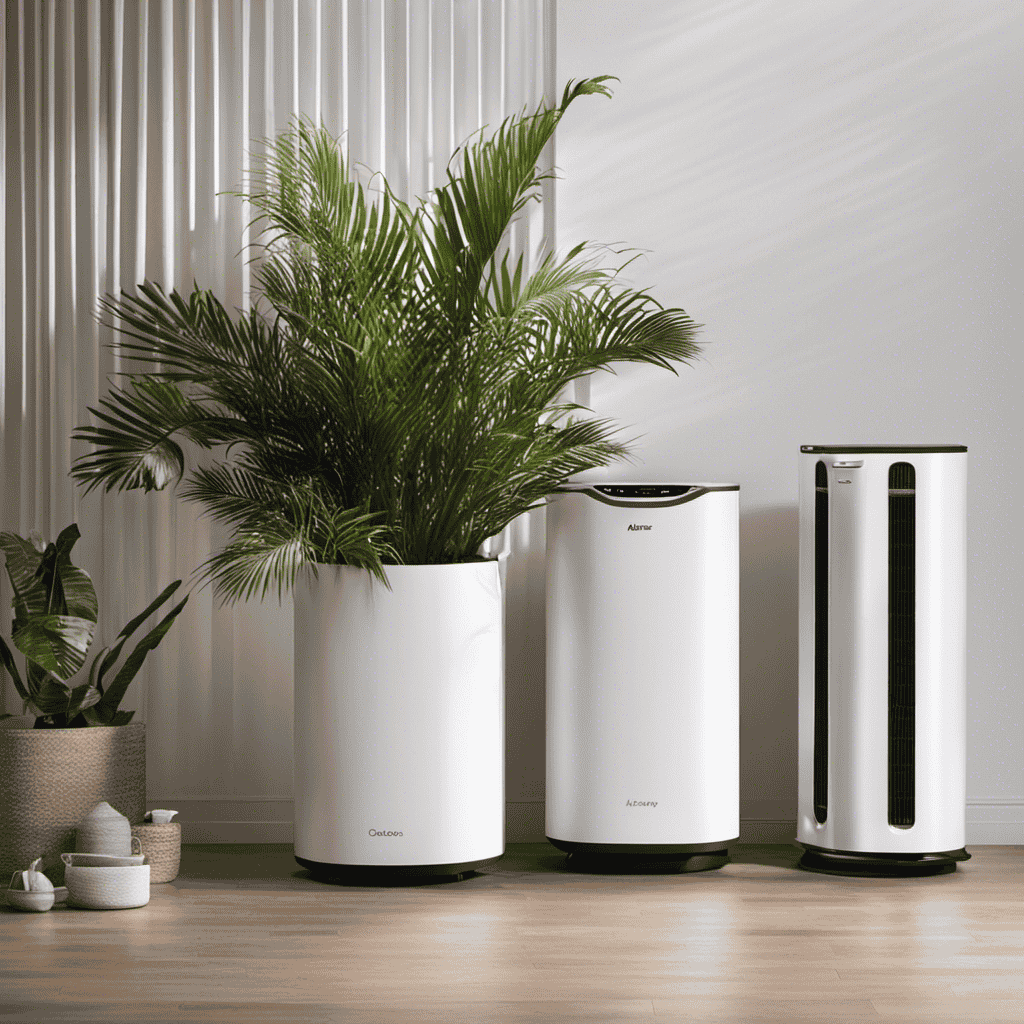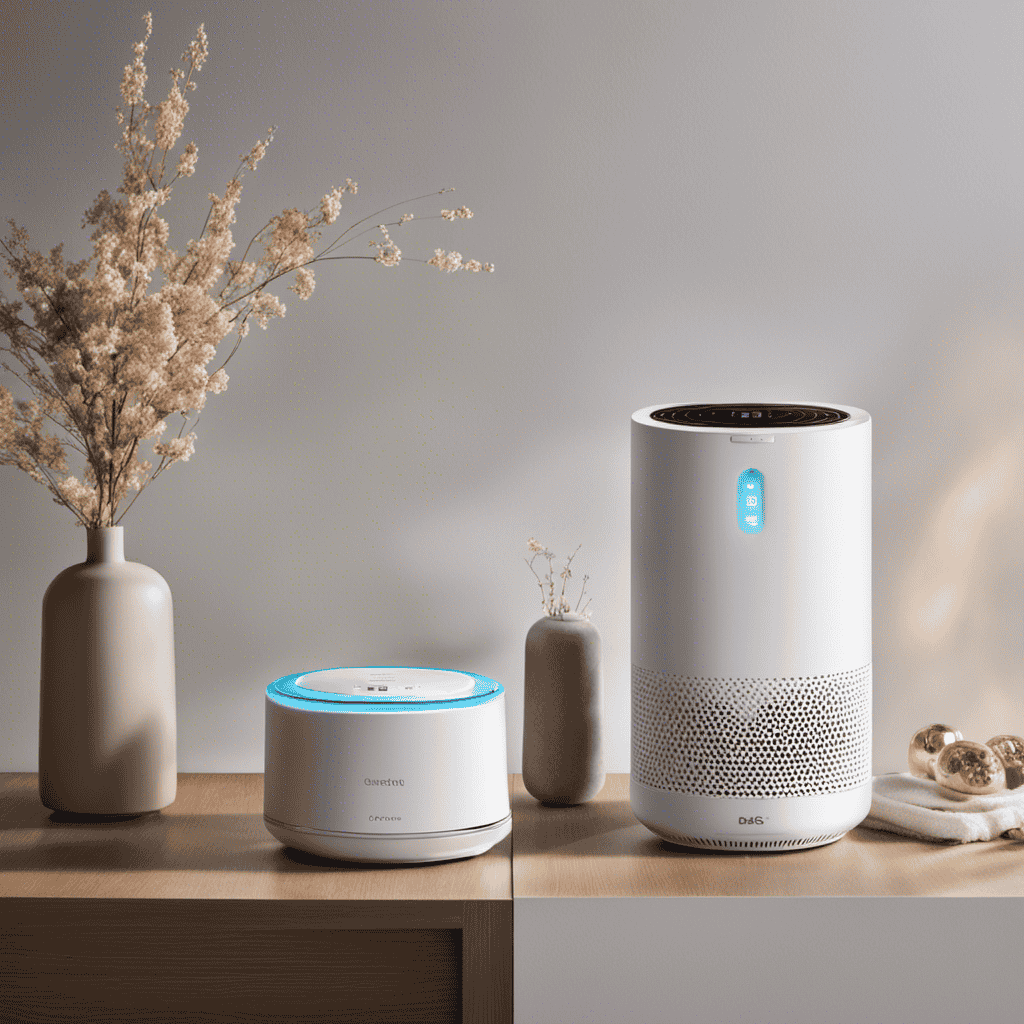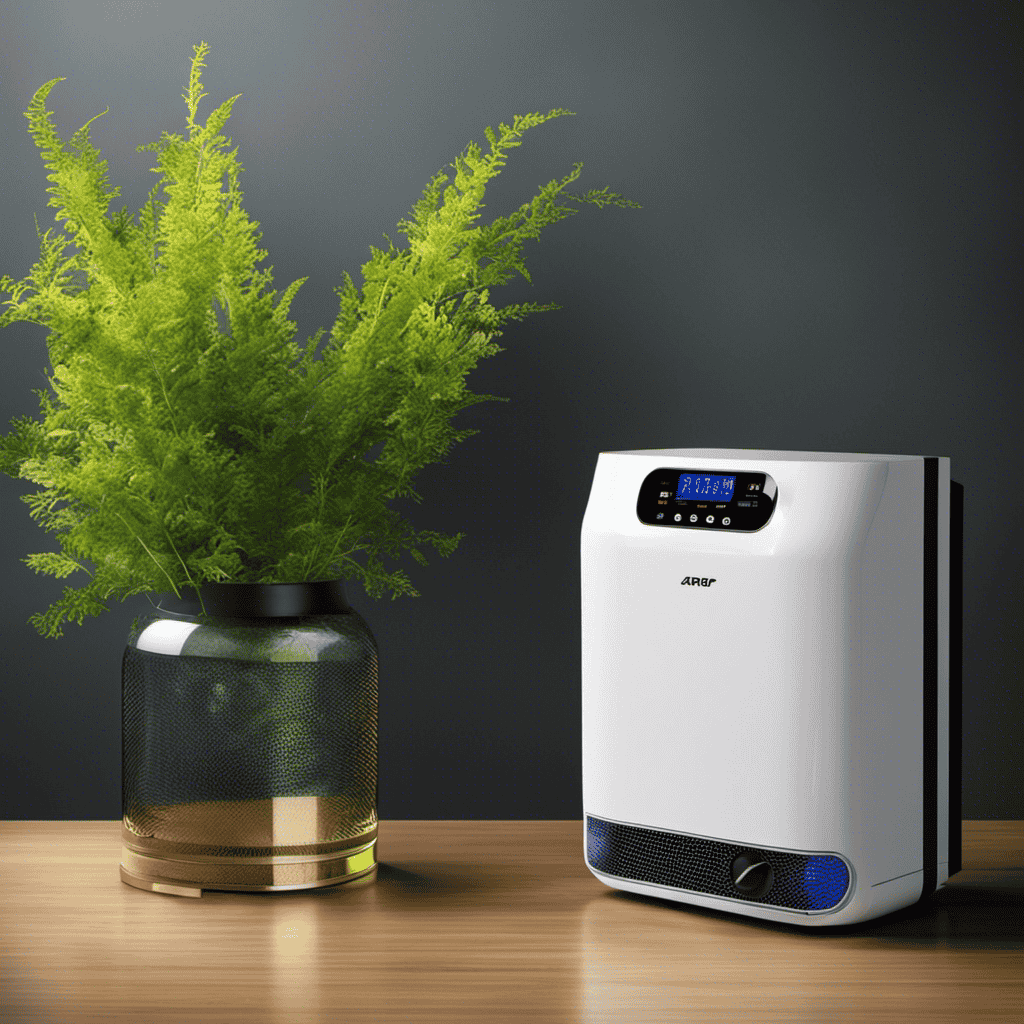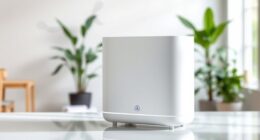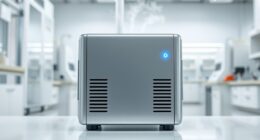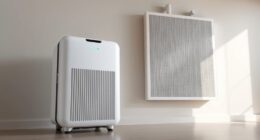Wow, locating the ideal air purifier may seem like looking for a needle in a haystack. But don’t worry, air quality enthusiasts! In this article, I’ll help you navigate through the key features to keep in mind when picking out an air purifier.
We’ll explore the different filter types, coverage area, CADR ratings, noise level, energy efficiency, maintenance, filter replacement, price range, customer reviews, and warranty and support.
So sit back, relax, and let’s dive into the world of cleaner, fresher air!
Key Takeaways
- Consider the size of the room and choose an air purifier with a coverage area that matches the room size.
- Evaluate the effectiveness of the air purification system based on the type of filter used and the CADR rating.
- Pay attention to the CADR ratings, which indicate the unit’s ability to remove pollutants from the air.
- Consider the noise level of the air purifier and look for models with low decibel ratings for quiet operation.
Filter Types
There are different filter types available for air purifiers. When choosing an air purifier, it is important to understand the different options and how they work.
One popular filter type is the HEPA filter, which stands for High Efficiency Particulate Air. HEPA filters are designed to capture particles as small as 0.3 microns, such as dust, pollen, pet dander, and mold spores. They are highly effective in improving indoor air quality and are often recommended for individuals with allergies or asthma.
Another commonly used filter type is the activated carbon filter. Activated carbon filters are excellent at removing odors, gases, and chemicals from the air. They work by adsorbing these pollutants onto the surface of the carbon, effectively trapping them and preventing them from being released back into the air.
When choosing an air purifier, considering the type of filter used is crucial in ensuring optimal air purification.
Coverage Area
When it comes to choosing an air purifier, two key factors to consider are room size requirements and effective air purification.
It is important to determine the size of the room where the air purifier will be used, as different models have different coverage areas.
Additionally, the effectiveness of the air purification system should be evaluated based on factors such as the type of filter used and the CADR (Clean Air Delivery Rate) rating.
Room Size Requirements
To determine the right air purifier for you, consider the size of the room you want to purify. Room size limitations play a crucial role in choosing the most effective air purifier that can meet your needs.
Here are three factors to consider when it comes to room size requirements:
-
Square footage: Measure the dimensions of the room to determine its square footage. This will help you identify the appropriate air purifier size for optimal air quality improvement.
-
Air changes per hour (ACH): ACH refers to how many times an air purifier can filter the entire room’s air in one hour. Higher ACH rates are recommended for larger rooms to ensure thorough purification.
-
Clean Air Delivery Rate (CADR): The CADR rating indicates the air purifier’s effectiveness in removing pollutants from the air. Compare the CADR rating to the room size to find a suitable purifier.
Considering these factors will help you choose an air purifier that is tailored to your room size limitations, ensuring effective air purification.
Effective Air Purification
Choosing the right size air purifier based on room dimensions, ACH, and CADR ratings is essential for effective purification.
When it comes to air purifiers, size matters. A unit that is too small for the room will not be able to effectively clean the air, while a unit that is too large may consume unnecessary energy.
To ensure optimal performance, it is important to consider the square footage of the room and match it with the recommended coverage area of the air purifier.
Additionally, pay attention to the Clean Air Delivery Rate (CADR) ratings, which indicate the unit’s ability to remove pollutants from the air.
CADR Ratings
When it comes to air purifiers, understanding the importance of CADR ratings is crucial.
CADR, or Clean Air Delivery Rate, measures the effectiveness of an air purifier in removing pollutants from the air.
Choosing the optimal CADR ratings for your specific needs ensures that you are investing in an air purifier that will efficiently clean the air in your space.
CADR Importance
The CADR rating is an important factor to consider when selecting an air purifier. It measures the effectiveness of an air purifier in removing pollutants from the air. Here are three reasons why the CADR rating is important:
-
Efficiency: The CADR rating indicates how quickly an air purifier can clean the air in a specific room size. A higher CADR rating means the purifier can remove more pollutants in a shorter amount of time, ensuring cleaner air for you and your family.
-
Air Quality Standards: The CADR rating is based on standardized testing methods that are used to evaluate air purifiers. These tests measure the purifier’s ability to remove smoke, pollen, and dust from the air. By choosing a purifier with a higher CADR rating, you can be confident that it meets or exceeds industry air quality standards.
-
Health Benefits: By improving indoor air quality, a purifier with a high CADR rating can help reduce the risk of respiratory issues, allergies, and other health problems associated with poor air quality. It can also create a more comfortable and pleasant living environment.
Overall, considering the CADR rating when selecting an air purifier is essential for ensuring the effectiveness and efficiency of the device in improving indoor air quality.
Choosing Optimal Ratings
To find the optimal ratings for your needs, you should consider the CADR rating and its impact on air purification.
The CADR, or Clean Air Delivery Rate, is a measure of how effectively an air purifier can remove pollutants from the air. It is important to choose a purifier with a CADR rating that matches the size of the room you want to purify. This ensures optimal performance and air quality improvement.
Research has shown that higher CADR ratings result in faster and more efficient removal of pollutants, such as dust, pollen, and smoke.
Noise Level
One thing to consider when choosing an air purifier is its noise level. Opting for a silent operation can make a significant difference in the comfort of your home.
Here are three key factors to keep in mind when evaluating the noise level of an air purifier:
-
Decibel levels: Look for air purifiers with a low decibel rating. A decibel level between 20 and 40 is considered quiet, while anything above 60 can be quite noisy.
-
Fan speed settings: Some air purifiers offer adjustable fan speed settings. This allows you to customize the noise level based on your preferences. Opting for a lower fan speed can reduce noise while still maintaining effective air purification.
-
Noise reduction features: Certain air purifiers come with noise reduction features such as foam padding or insulated covers. These can help minimize the sound produced by the purifier, ensuring a quieter operation.
Considering the noise level of an air purifier can greatly enhance your overall experience and create a more peaceful environment in your home.
Energy Efficiency
Opting for an energy-efficient air purifier can help you save on electricity bills while still enjoying clean air in your home. When considering energy efficiency, it’s essential to look for air purifiers that have been designed with energy savings in mind. These models typically use advanced technologies, such as energy-efficient motors and sensors, to minimize power consumption without compromising on performance.
Additionally, eco-friendly options are available that not only reduce energy usage but also have a smaller carbon footprint. By choosing an energy-efficient and eco-friendly air purifier, you can contribute to a greener environment while enjoying the benefits of clean air in your home.
Now, let’s explore the additional features that you should consider when selecting an air purifier.
Additional Features
When considering additional features, prioritize a user-friendly control panel that allows for easy adjustment of settings and monitoring of air quality. Here are three key features to look for in smart technology and air quality monitoring:
-
Real-time data: A good air purifier should provide accurate and up-to-date information about air quality in your home. This includes measurements of pollutants like PM2.5, VOCs, and carbon dioxide levels.
-
Mobile app integration: Many modern air purifiers come with companion mobile apps that let you control and monitor the device remotely. This feature allows for adjusting settings, receiving notifications, and accessing historical data from your smartphone or tablet.
-
Smart automation: Some air purifiers can automatically adjust their operation based on current air quality. They can detect pollution spikes and increase fan speed or activate special modes to quickly clean the air.
Considering these features ensures you have a smart air purifier that effectively monitors and improves air quality in your home.
Now, let’s delve into the important topic of maintenance and filter replacement.
Maintenance and Filter Replacement
When it comes to maintaining an air purifier, two key factors to consider are the frequency of filter replacement and the cost associated with it.
The frequency of replacement depends on various factors such as the type of filter, the air quality in your area, and the usage of the purifier. It is important to analyze these factors and choose a filter that offers a balance between longevity and effectiveness.
While considering the frequency of replacement, it is also crucial to take into account the cost of replacing the filters over time. This includes not only the initial cost of purchasing the filter but also the expenses incurred in regularly replacing it.
Frequency of Replacement
To ensure your air purifier is effective, you should regularly replace the filters. The frequency of replacement depends on various factors, such as the type of air purifier and the level of air pollution in your area. Here is a cost comparison and replacement schedule for common types of filters:
-
Pre-filters: These are the first line of defense and capture large particles like dust and pet hair. They should be replaced every 3 months to maintain optimum airflow and efficiency.
-
HEPA filters: These filters remove 99.97% of particles as small as 0.3 microns. They typically last for 6 to 12 months, but it’s recommended to check the manufacturer’s guidelines for your specific model.
-
Carbon filters: These filters are effective in removing odors and harmful gases. They usually last for 6 to 12 months, depending on the level of pollutants in your environment.
Regularly replacing your air purifier filters ensures that it continues to provide clean and fresh air.
Now let’s explore the cost of replacement filters and how it can impact your overall expenses.
Cost of Replacement
The frequency of replacing air purifier filters depends on various factors, such as the type of filter and the level of pollution in your area. However, it’s also important to consider the cost of replacement when choosing an air purifier. A cost analysis can help you determine the long term investment of owning and maintaining an air purifier. To give you a better understanding, here is a breakdown of the average cost of replacing filters for different types of air purifiers:
| Type of Filter | Average Cost per Replacement |
|---|---|
| HEPA Filter | $20 – $50 |
| Carbon Filter | $20 – $40 |
| Pre-Filter | $10 – $20 |
| UV-C Light Bulb | $15 – $30 |
Price Range
Finding an air purifier that fits your budget can be challenging, but there are options available in various price ranges. When considering the price comparison of air purifiers, it’s important to keep in mind your budget and the features you require.
Here are three budget options to consider:
-
Basic models: These air purifiers are usually the most affordable and offer essential features such as a HEPA filter to remove allergens and pollutants from the air. While they may lack advanced features like smart controls or air quality sensors, they still provide effective air purification at a lower cost.
-
Mid-range models: These air purifiers offer a balance between affordability and additional features. They often include extras like multiple fan speeds, programmable timers, and filter replacement indicators. These options give you more control over the air purification process without breaking the bank.
-
High-end models: These air purifiers are the most expensive but come with advanced features. They may include Wi-Fi connectivity, smartphone apps for remote control, and advanced sensors to monitor and adjust the air quality automatically. These options are ideal for those looking for the latest technology and convenience.
Customer Reviews and Ratings
Customer reviews and ratings can provide valuable insights when choosing an air purifier that meets your needs and budget. Taking into account customer feedback and user experiences can help you make an informed decision about which air purifier to purchase.
By reading reviews and ratings from other users, you can gain a better understanding of the pros and cons of a particular air purifier model. Pay attention to the overall rating as well as specific comments about the air purifier’s performance, noise level, filter effectiveness, and durability. Look for patterns in the feedback to get a sense of the consistency of the product’s performance.
Additionally, consider the credibility of the reviewers and their specific needs and circumstances. By considering customer reviews and ratings, you can make a more confident choice when it comes to selecting an air purifier.
Warranty and Support
When considering warranty and support options, you should prioritize finding a company that offers responsive customer service and a comprehensive warranty for your air purifier. This is crucial for ensuring customer satisfaction and reliability.
Here are three key factors to consider:
-
Quick and Responsive Customer Service: Look for a company that has a dedicated customer service team available to assist you with any questions or concerns you may have. A prompt and helpful response can make a significant difference in your overall experience.
-
Comprehensive Warranty Coverage: A comprehensive warranty is essential to protect your investment. It should cover not only manufacturing defects but also any potential issues that may arise during the expected lifespan of the air purifier.
-
Positive Customer Reviews: Take the time to research and read customer reviews about the company’s warranty and support services. Look for positive feedback that highlights their responsiveness and willingness to resolve any issues that may occur.
Frequently Asked Questions
How Long Does an Air Purifier Typically Last Before Needing to Be Replaced?
Air purifiers typically last 5-10 years before needing to be replaced. Signs of a failing air purifier include decreased air quality, strange noises, and frequent breakdowns. Regular maintenance can extend its lifespan.
Can an Air Purifier Help With Allergies or Asthma Symptoms?
Yes, an air purifier can help with allergies or asthma symptoms. It is important to choose an air purifier that is effective and offers benefits such as removing allergens and pollutants from the air.
Are There Any Health Risks Associated With Using an Air Purifier?
Using an air purifier can have incredible health benefits. It effectively removes harmful pollutants, allergens, and irritants from the air, reducing the risk of respiratory issues. However, it’s important to choose a high-quality purifier to ensure its effectiveness.
Can an Air Purifier Remove Odors From the Air?
Yes, an air purifier can effectively remove odors from the air. Some of the best air purifier brands have advanced filtration systems that can eliminate various types of odors, leaving the air fresh and clean.
Do Air Purifiers Require Regular Maintenance, and if So, How Often?
Air purifier maintenance is essential for optimal performance. Regular cleaning and filter replacement are necessary to ensure clean air. The frequency of maintenance depends on usage and the manufacturer’s recommendation.
Conclusion
In conclusion, choosing the right air purifier requires careful consideration of various factors.
From filter types to coverage area, CADR ratings to noise level, energy efficiency to maintenance and filter replacement, and price range to customer reviews and ratings, each aspect plays a crucial role in making an informed decision.
While some may argue that air purifiers are an unnecessary expense, the evidence-based benefits of improved indoor air quality and reduced allergens cannot be overlooked.
Investing in a high-quality air purifier will not only provide health benefits but also peace of mind.
